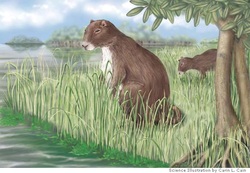History
Let’s start with ancient history: 8 million years ago.
In the year 2000, scientists dug up the fossil of what they believe to be the world’s biggest guinea pig: Phoberomys pattersoni. They believed it lived about 8 million years ago, was 9 feet long, stood more than 4 feet high, and weighed about 1,500 pounds (the size of a buffalo, and 700 times bigger than guinea pigs today!). I read a book about this ancient guinea pig: Great Big Guinea Pigs by Susan Roth, published by Bloomsbury Publishing, NY, NY 2006. It sounds like this giant guinea pig would have made an interesting pet!
Now let’s talk about normal sized guinea pigs in more recent history. The Cavia pocellus, or cavy (commonly known as a guinea pig) is a rodent that is native to South America where it was raised by the Incas for food and religious sacrifice.
In the wild, it resides in the Andes Mountain area in Peru in small colonies of about 10. They live in burrows in rocky areas, grasslands and forest edges and they are grayish/brownish in color. They don’t have many defenses, so they live in groups for protection and call out to each other if they sense danger. They create trails between their burrows so they can easily run for cover if they are in danger. They have a pecking order and only the dominant male mates with the females.
About 300 years ago, cavies were introduced to Europe and became popular pets, especially after the Queen adopted one.
In the 17th century, guinea pigs were introduced to North America and became popular pets here. In the 1800’s, laboratories started using them for experiments. Later, people started breeding them for show.
The National Pet Stock Association was formed in 1910 to oversee the breeding of small animals like guinea pigs and rabbits, and changed its name 10 years later to the American Rabbit and Cavy Breeders Association. When the guinea pig breeders split off from that group to form their own group (the American Cavy Breeders Association), the original rabbit/cavygroup changed its name to the American Rabbit Breeders Association (ARBA). Later the two groups combined again, but they kept the ARBA name. The American Cavy Breeders Association is a group within ARBA now.
Let’s start with ancient history: 8 million years ago.
In the year 2000, scientists dug up the fossil of what they believe to be the world’s biggest guinea pig: Phoberomys pattersoni. They believed it lived about 8 million years ago, was 9 feet long, stood more than 4 feet high, and weighed about 1,500 pounds (the size of a buffalo, and 700 times bigger than guinea pigs today!). I read a book about this ancient guinea pig: Great Big Guinea Pigs by Susan Roth, published by Bloomsbury Publishing, NY, NY 2006. It sounds like this giant guinea pig would have made an interesting pet!
Now let’s talk about normal sized guinea pigs in more recent history. The Cavia pocellus, or cavy (commonly known as a guinea pig) is a rodent that is native to South America where it was raised by the Incas for food and religious sacrifice.
In the wild, it resides in the Andes Mountain area in Peru in small colonies of about 10. They live in burrows in rocky areas, grasslands and forest edges and they are grayish/brownish in color. They don’t have many defenses, so they live in groups for protection and call out to each other if they sense danger. They create trails between their burrows so they can easily run for cover if they are in danger. They have a pecking order and only the dominant male mates with the females.
About 300 years ago, cavies were introduced to Europe and became popular pets, especially after the Queen adopted one.
In the 17th century, guinea pigs were introduced to North America and became popular pets here. In the 1800’s, laboratories started using them for experiments. Later, people started breeding them for show.
The National Pet Stock Association was formed in 1910 to oversee the breeding of small animals like guinea pigs and rabbits, and changed its name 10 years later to the American Rabbit and Cavy Breeders Association. When the guinea pig breeders split off from that group to form their own group (the American Cavy Breeders Association), the original rabbit/cavygroup changed its name to the American Rabbit Breeders Association (ARBA). Later the two groups combined again, but they kept the ARBA name. The American Cavy Breeders Association is a group within ARBA now.


